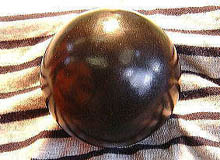 A mud ball with a shine rating of 5, the highest score. (Association of Nippon Doro-dango Science) |
|
SHINY MUD BALLS:
Kyoto Professor Taps into the Essence of Play
October 5, 2001
At elementary schools, kindergartens, and preschools all across Japan, kids are losing themselves making hikaru dorodango, or balls of mud that shine. Behind this boom is Professor Fumio Kayo of the Kyoto University of Education. Kayo is a psychologist who researches children's play, and he first came across these glistening dorodango at a nursery school in Kyoto two years ago. He was impressed and devised a method of making dorodango that could be followed even by children. Once Kayo teaches children how to make these mud balls, they become absorbed in forming a sphere, and they put all their energy into polishing the ball until it sparkles. The dorodango soon becomes the child's greatest treasure. Kayo sees in this phenomenon the essence of children's play, and he has written academic papers on the subject. The mud balls could also offer fresh insights into how play aids children's growth.
Professor Develops Method
Inside his office at the university, Kayo keeps a dorodango in a wooden box, wrapped in cloth. The shiny ball of dried mud is eight centimeters (about three inches) in diameter and is amber colored with a touch of dark green. Professor Kayo developed his own scale for measuring a dorodango's luster, and this one rates a "4." The shiniest dorodango rates a "5," and Kayo keeps one of these at home.
Kayo first became interested in dorodango in May 1999. As part of his research in developmental pshychology, Kayo visited a Kyoto preschool once a week. When Kayo made mud balls with the children, a teacher at the preschool told him, "I'll show you a real dorodango," and proceeded to produce a shiny one for Kayo.
Why would a lump of mud shine? Kayo became taken with this question and tried to outdo the preschool teacher. But after trying many times, Kayo found that he just could not make a shiny mud ball. Once, he thought he had succeeded, but after a few days the mud ball lost its luster. Through 200 failed experiments and an analysis using an electron microscope, Kayo was finally able to devise a method of making dorodango that could be followed by anyone, including children.
 About 70 people of all ages took part in this dorodango-making event. (Association of Nippon Doro-dango Science) |
|
When Kayo taught his new method to children, they were hooked. Kids would spend a long time kneading the mud and then polishing it until it shined. The children soon became attached to their mud balls and treasured them even if the shape was bad or if they did not shine.
In the process of making dorodango, the children demonstrated behavior that was surprising from the perspective of developmental psychology. A two-year-old child would walk behind Kayo, imitating his actions. At three, children would come up beside him and snatch his dirt. Four and five year olds pretended to ignore him out of pride, but afterwards they could be seen working with determined expressions on their faces. Children could also be found sharing information about where to find the best dirt and sand for making dorodango or even sometimes keeping such information secret. Dorodango were made famous all over Japan when public broadcaster NHK (Japan Broadcasting Corp.) took up the phenomenon in a program aired nationally in June 2001.
In the field of developmental psychology up to now, play that developed children's imagination and creativity, such as role playing and drawing, was deemed important. But Professor Kayo is searching for whether developmental psychology has overlooked something very important: the experimentation children undertake in everyday activities like eating, getting dressed, and sleeping. He feels that making shiny mud balls is a good way of searching for the essence of children's play. Kayo believes that the answers lie within the hearts of children, and he continues to visit the preschool once a week.
How to Make Shiny Dorodango
- Pack some mud into your hand, and squeeze out the water while forming a sphere.
- Add some dry dirt to the outside and continue to gently shape the mud into a sphere.
- When the mass dries, pack it solid with your hands, and rub the surface until a smooth film begins to appear.
- Rub your hands against the ground, patting and rubbing the fine, powdery dirt onto the sphere. Continue this for two hours.
- Seal the ball in a plastic bag for three or four hours. Upon removing the sphere, repeat step 4, and then once again seal the sphere in a plastic bag.
- Remove the ball from the bag, and if
it is no longer wet, polish it with a cloth until it shines.
|
Copyright (c) 2001 Japan Information Network. Edited by Japan Echo Inc. based on domestic Japanese news sources. Articles presented here are offered for reference purposes and do not necessarily represent the policy or views of the Japanese Government. |



